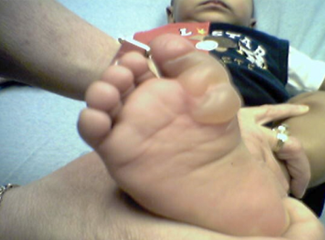Blister on Toddler's Foot: Burn? Blistering Disease? Abuse?
Blisters are relatively common in a busy office or pediatric ED.Child abuse should be included in the differential diagnosis of blisters, along with immersion burn, blistering distal dactylitis, and epidermolysis bullosa simplex.

An 18-month-old boy was brought to an indigent care clinic with a blister on his foot. His mother stated that she had cared for the child the prior evening and that no blister was present at that time. She reported that her teenage daughter had dressed the boy before the mother brought him to daycare that morning. The stated concern was that something had happened to the child at the daycare center to cause the injury.
When the mother was pressed for more details, she remembered that the child was crying as she left the house and also as she left him at daycare. This was not unusual but, in retrospect, she thought the child had been crying more than was customary.
A call was made to the daycare center. The daycare worker commented that the child had been more irritable than usual all day. The worker also recalled that the child had fallen asleep at naptime with his shoes on. There was no history of trauma.
Do you think this child has been abused?
Click here for answer and discussion
Answer: Blister from Tight Fitting Shoes
The historical point that mother did not voluntarily provide was that the sister had put the wrong pair of shoes on the child. After the examination, the shoes were placed back on the child and he began to cry. The shoes were very tight and the child’s toes were cramped in the shoe.
Blisters like this are relatively common in a busy office or pediatric ED. Abuse should be included in the differential diagnosis, along with immersion burn, blistering distal dactylitis,1 and epidermolysis bullosa simplex.2,3
This child’s injury could be compared with a pressure necrosis, for lack of a better example. There is virtually nothing written on this in the abuse literature, but an effort is underway to write a review of several such cases. The classic history is much the same as described in this case. The child is fine and then irritable all day; and new shoes are usually part of the story. The diagnosis is easiest to confirm with follow-up examination. Symptoms of the other disorders in the differential do not resolve quickly; however, a blister from tight shoes resolves in a day or two, as it did in this child. Blistering distal dactylitis is a bacterial infection that requires antibiotic therapy.
References
1. Lyon M, Doehring MC. Blistering distal dactylitis: a case series in children under nine months of age. J Emerg Med. 2004;26:421-423.
2. Coulombe PA, Kerns ML, Fuchs E. Epidermolysis bullosa simplex: a paradigm for disorders of tissue fragility. J Clin Invest. 2009;119:1784–1793. doi:10.1172/JCI38177. http://www.jci.org/articles/view/38177
3. Epidermolysis bullosa. Dermnet.http://www.jci.org/articles/view/38177